Best Cows for Dairy Farming India – Noteworthy Cross-bred Cows
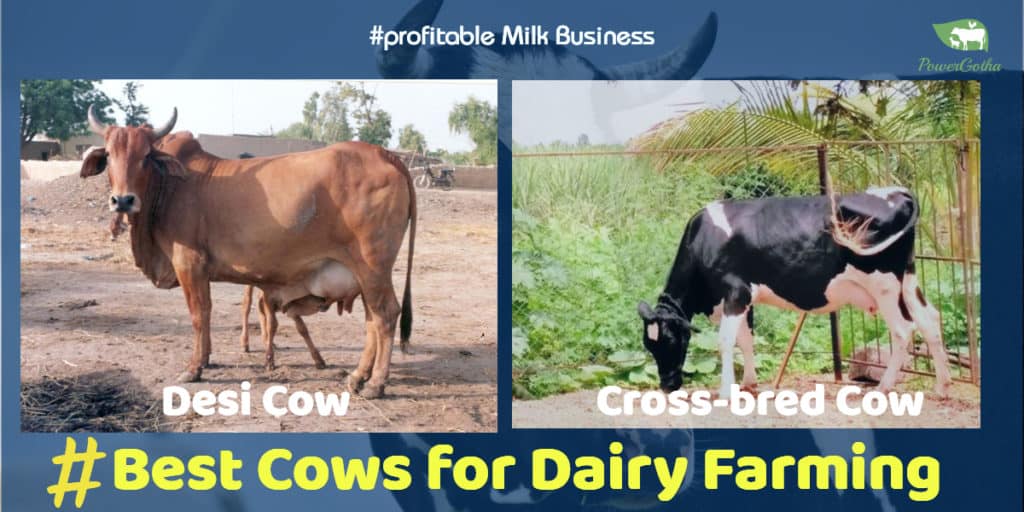
Dairy Farming in India struggled to cope with demand of ever increasing population of India – until the White Revolution or Operation Flood – the project lead by Dr Verghese Kurien.
The white revolution also meant entry of Cross-bred cows in India, to combine high sustainability and disease resistant, heat resistant characteristics of Indian Desi Cows with that of Exotic cow breeds.
What are the Best Cows for Dairy Farming in India?
There’s no single answer to above question. We should be relying on cows bred in our own farm to rear Best cows for Dairy Farming.
Modern dairy farmers for obvious reasons have shown inclination towards cross-breeds which are more productive at the same time also prone for diseases.
Presently, the Indian Farmers are using Holestein Cow or Holstein Friesian (HF) cow and Jersey Cow crossbred with Desi Indigenous Cows.
However, many dairy farmers have managed to gain high production even from Noteworthy Desi Cows or Indigenous cows. Specially, Gir cows in Gujarat and Sahiwal in Punjab, Haryana have proven to produce large quantities of milk.
In this article we will look at Best Cross-bred cows for Dairy Farming including the information that of HF cow and Jersey cow provided at the end of the article.
Cross Breeds of Cattle in India for Dairy Farming
As discussed in the earlier article about the cross-breeding techniques for Indian breeds of milch animals are becoming popular amongst the dairy farmers in the country.
There are 40 well defined breeds of cows and 13 well defined breeds of buffaloes in India. These breeds of indigenous milch animals have evolved over years, are well accustomed to the environment, hot climatic conditions, developed to perform over poor quality feed, developed a resistance to diseases and the milk production is also good.
India is the highest producers of milk in the world with almost 187.7 million tones of milk produced in the year 2018-19. Another report published by The Economic Times dated 11th Nov,2014 states that the demand for Indian cattle is increasing in Australian and Brazilian Market due to the above mentioned qualities:
“Indian breed cows are in demand in Brazil and Argentina due to their sturdy qualities and high milk yield,”
However, as the dairy industry grew the crossbreeding of milch animals also increased. The reason behind the same was that it was more economical for the dairy farmers as the production of milk increased and it also had an impact on the year round production of milk, which provided sustainability to the dairy farmers.
What is Crossbreeding of Cows ?
Crossbreeding in simpler terms may be defined as mating of animals from different established breeds. And the resultant progeny is called a cross-bred.
As per the 19th Livestock census-2012, the crossbred milch cattle increased from 14.4 million to 19.42 million, i.e. an increase of around 34.78% from the last year. The recent Livestock census-2019 i.e. the 20th has the following noteworthy findings:
- The total livestock in India has seen an increase of 4.6% over the livestock census 2012 making the total population of livestock to be 535.78 million.
- Total number of cattle has shown an increase of 0.8% over the last year taking the total to 192.49 million.
- Out of the given number of cattle, 145.12 million is the population of female cows, which is 18% higher than over the previous census.
- While the population of indigenous/non-descript female cattle has increased only 10%, the population of exotic/crossbred cattle has increased 26.9% over the previous census.
(source)
The table showing the data from the recent livestock census clearly shows the inclination of dairy farmers towards the exotic/crossbred cattle:
Exotic/Crossbred and Indigenous/Non-Descript Cattle Population-Male, Female and Total
| Category | Population (In million) 2012 | Population (In million) 2019 | % Change |
|---|---|---|---|
| Total Cattle | 190.9 | 192.49 | 0.8 |
| Exotic/Crossbred | |||
| Male | 5.97 | 3.46 | -42 |
| Female | 33.76 | 46.95 | 39.1 |
| Total Exotic/Crossbred | 39.73 | 50.42 | 26.9 |
| Indigenous/Non-Descript | |||
| Male | 61.95 | 43.94 | -29.1 |
| Female | 89.22 | 98.17 | 10 |
| Total Indigenous/Non-Descript | 151.17 | 142.11 | -6 |
cattle count
(source: https://pib.gov.in/PressReleasePage.aspx?PRID=1588304)
The history of crossbreeding in India dates back to 1875, where by using Shorthorn bull on local cows and producing “Taylor” breed of cow. There are many crossbreeds in of cattle and buffaloes found in India. With the advent of new technologies, scientist took the step of crossbreeding further and crossbreeding of indigenous cows like Sahiwal, Gir, Hariana, Kankrej and Red Sindhi cows with exotic breeds like Holestein Friesian, Jersey and Brown Swiss Sires.
As discussed earlier, Cross breeding means mating the animals of different species to produce progeny or use their semen to produce crossbred off springs. As with any other discoveries, the cross breeding also has some advantages as well as disadvantages that are listed below:
Advantages of Cross-bred cows for Dairy Farming in India
- It gives the liberty to transmit the desired characters of the exotic parent to the progeny, which may not be present in the indigenous parent.
- The cross bred progeny may have characteristics of exotic parent like high milk productivity, higher birth weight, better reproductive capacity, early maturity and also the desirable characteristics of the indigenous parent like resistance to heat, better adjustment to climatic changes, resistance to certain diseases, survival on minimum/coarse fodder.
- The results in the milk yield are seen more quickly in the crossbred progeny.
- The improvement in the production of milk can be observed all year round which helps in providing sustainable income to the dairy farmers even in climatic conditions when the milk production is supposed to be low. Thus, improving profit in the business.
Disadvantages of Cross-bred cows for Dairy Farming
- For the purpose of cross breeding, it is a necessary that the farmer maintains at least one animal each of the pure breed.
- It is fact that the breeding merit of the crossbred animal may reduce.
- Primary investment and maintenance cost is very high.
- Animals may become more susceptible to disease like Foot and mouth disease, Babesiosis, Theileriosis, Mastitis, Milk fever, Ketosis etc.
- The animals become less tolerant to heat shock or heat stroke.
Keeping in mind both the advantages and disadvantages of cross breeding, it is safe to say that cross breeding is profitable for the dairy farmers in the future run and thus is a good option.
How Cross Breeding is carried out for Dairy Farming
Given below are some of the exotic and indigenous breeds that are cross bred in our country and their origin.
Exotic Cows used for Cross Breeding in India
| S.No | Name of the Breed | Native breed | Specific region | Assembling centre | Remarks |
|---|---|---|---|---|---|
| 1 | Brown Swiss | Switzerland | - | India, Pakistan & other Asian countries | Dairy breed |
| 2 | Holstein Friesian | Holland | Province of North Holland and West Friesland | Throughout the country (crossbreds) | Dairy breed |
| 3 | Jersey | British Isles | Island of Jersey | Crossbreds available in all states. | Dairy breed |
(Source: National Dairy Development Board)
Indian Desi Breed of cattle used for Crossbreeding in Dairy Farming
| S.No. | Breed | Habitat/Main State | Breeding Tract Districts | Assembling Center | Areas of demand | Remarks |
|---|---|---|---|---|---|---|
| 1 | Hallikar | Karnataka | Tumkur, Hassan & Mysore | Dodbalapur, Chickballapur, Harikar, Devargudda, Chikkuvalli, Karuvalli, Chittavadgi (T.N.) North Arcot (T.N.) Hindupur, Somaghatta, Anantpur (A.P.) | Dharwar, North Kanara, Bellary (KT) Anantur & Chittur (A.P.), Coimbatore North Arcot, Salem (T.N.) | Draught breed |
| 2 | Kangayam | Tamil Nadu | Erode | Avanashi, Tirppur, Kannauram, Madurai Athicombu | Southern Districts of Tamil Nadu | Draught breed |
| 3 | Red Sindhi | Pakistan All parts of India | - | - | - | Dairy breed |
| 4 | Tharparkar | Pakistan(sind) | Umarkot, Naukot, Dhoro Naro Chor | Balotra (Jodhpur), Puskar (Ajmer), Gujarat State | - | Dairy breed |
| 5 | Vechur | Kerala | - | Vaikom, Mannuthy (Kerala State) | - | - |
(Source: National Dairy Development Board)
Cross Breed Cows evolved in India for Dairy Farming
As more and more farmers are getting inclined towards cross bred cows, it is important to understand the cross breeds evolved in India and their characteristics. Some of the cross breeds that have evolved in India are:
1. Sunandini
The origin of the Sunandini breed of cattle can be traced back to the period of 1964-67, when 22 Brown Swiss bulls and 45 cows were imported. Along with this semen from 11 more bulls was also imported. The bulls were then mated with around 140 nondescript cows. 40 Jersey bulls were also imported for the purpose of cross breeding.
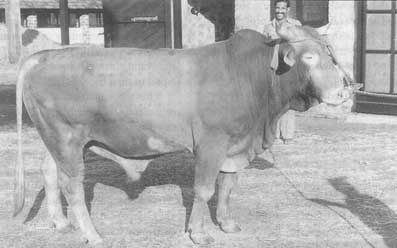
The Kerala Livestock Development Board Ltd. (KLDB) actually imported two consignments full of exotic bull semen that included Jersey, American Brown Swiss and Holstein, for the purpose of production of F1 bulls.
With the introduction of Jersey and Holstein blood in, the characteristics of cross breed have changed and it is to be noted that more importance was paid to make it more economical rather than phenotypic.
Short description of Sunandini Cow breed :
| Characteristic | Sunandini |
|---|---|
| Origin | Kerela |
| Cross bred amongst | Nondescript cattle and Brown swiss/Jersey/Holstein-Friesian bull |
| Color | Light grey to black |
| Phenotypic Appearance | straight back and comparatively short flat head |
| Udder | Well developed |
| First calving | 32 months |
| Calving intervals | 13 months |
| Milk production | 2500kg/lactation |
2. Taylor
Cross breeding actually started in India (near Patna) somewhere around 1875 by crossing Shorthorn bulls with local cows and the result was the breed called Taylor. The However, it was introduced on more scientific levels in the years 1910 to 1932. It was called as Sinha (1951). Later on local cattle were crossed with Jersey breed of exotic cows and the progeny was called “Jersind”.
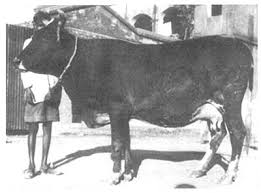
Short description of Taylor Cow:
| Characteristic | Taylor |
|---|---|
| Origin | Patna (India) |
| Cross bred amongst | Local cattle and Jersey |
| Color | Various shades of grey may include spots and strips like zebra |
| Phenotypic Appearance | Absence of hump and dew lap |
| Udder | Full developed |
| Milk production | 5-6 liters per day |
3. Karan Swiss:
Karan Swiss is one of the most popular crossbred cows of India. It was developed at the National Dairy Research Institute, Karnal, India.
What is Karan Swiss Cow Breed for Dairy Farming?
Karan Swiss is a crossbred between Brown Swiss and Sahiwal.

The range of Brown Swiss in the breed may range from ½ to ¾ percent. Having Karan swiss cows/ox is quiet beneficial for the dairy farmers.
The milk production is more in the case of Karan Swiss cows as compared to the other breeds and the ox also can be used for other work such as ploughing the field and other physical work.
The short description of Karan Swiss:
| Characteristic | Karan Swiss |
|---|---|
| Origin | NDRI Karnal |
| Cross bred amongst | Brown Swiss bull and Sahiwal |
| Color | Shades of light grey to dark brown |
| Phenotypic Appearance | Sharp horns, small years, large body, medium neck and slightly dished forehead |
| Udder | Wide bowl shaped large udders |
| First calving | 28-30 months |
| Calving intervals | 13 to 14 |
| Milk production | 3500kg/lactation |
| Weight of male | 600-750 kg |
| Weight of female | 400-500 kg |
4. Karan Fries
Like Karan Swiss, Karan Fries was also developed in NDRI,Karnal, Haryana.
What is Karan Fries CrossBreed cow ?
Karan Swiss is a crossbred between Holstein-Friesian and Tharparkar

Karan Fries: Source Flickr
A Holstein-Friesian is considered to be the most milk producing cow in the world and can be easily found in most of the dairies because of this quality. Tharparkar cow however, has average milk producing capacity but its heat tolerance capacity and to survive in hot and humid climate makes it a desirable breed.
The Karan Fries, being a crossbreed of these two inherits the qualities of both the breeds, thus making it a sought-after breed by the dairy farmers.
| Characteristic | Karan Fries |
|---|---|
| Origin | NDRI Karnal |
| Cross bred between | Tharparkar Cow and Holstein-Friesian Bull |
| Color | White spots on the body, forehead, and tail of the cows |
| Phenotypic Appearance | Proportionate well built body |
| Udder | Large size |
| First calving | 30-32 months |
| Calving intervals | 13-14 months |
| Milk production | 3400 kg/lactation |
5. Frieswal Cow for Dairy Farming
What is Frieswal Cow in Dairy Farming?
The breed Frieswal was developed by the Indian Council of Agricultural Research (ICAR, New Delhi) in collaboration with military farms in India. It is a crossbreed between Holstein-Friesian Bull and Sahiwal Cow.
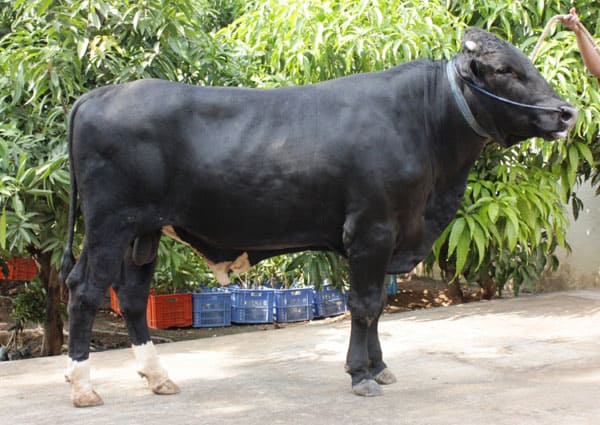
Frieswal bull – Source Genus ABS India
A Frieswal crossbred has 3/8 of Sahiwal and 5/8 of Holstein-Friesian inheritance. As already mentioned Holstein-Friesian is one of the top milk producing cattle in the world and hence desirable by most of the dairy farmers, Frieswal was an attempt, a successful attempt as it is known, to produce a progeny that inherits the qualities of both the breeds making it a more milk producing animal that has high tolerance for heat, humid and less susceptibility to diseases.
| Characteristic | Frieswal |
|---|---|
| Origin | ICAR, New Delhi |
| Cross bred between | Sahiwal cow and Holstein Friesisan |
| Color | Black and white |
| Phenotypic Appearance | Mostly adult animals have black muzzle and naval flap |
| Udder | Mostly symmetrical |
| First calving | 24-36 months |
| Milk production | Upto 4000 kg/lactation |
| Weight of male | 630-700 kg |
| Weight of female | 410 approx at the time of first calving |
This was about 5 Indian noteworthy Cross Bred cows that you must know to start learning about Dairy Farming.
There are two more Crossbred cows which do not fall under above 5 categories, and are popularly used. In fact, the next two cows are the only two breeds are majorly used across India for high milk yield and more income.
6. Holstein Friesian cow for Dairy farming – HF Cow
7. Jersey Cow for Dairy farming
How to select best cows for dairy farming ?
Any dairy farm can start only after buying good lot of healthy and high yielding dairy cows.
Ask yourself following questions before buying the animal.
- Milk requirement is home consumption or commercial?
- If commercial, is consumer seeks only milk or milk with high fat?
- if you want to select a high milk producing cow, do you have a facilities which are must to keep these animals?
The last question is of utmost importance, as many high yielding purebred animals are not suitable for Indian climate and perform poorly in spite of their genetic potential.
You might agree that, a dairy animal is reared for producing milk at least possible cost and reproduce replacement calf for future.
Farmers tend to select a cow based on her fantastic looks or appearance including cows with big udder size.
Farmers always buy animals from open market.
However, you might also agree that, another farmer sells off his animal most of the time when it is not producing enough milk. The cow in question is sure to have problems in conception, deformities, bad temperament or long disease history.
Then in such case how do you select the cows from mere appearance. Selecting a dairy animal is not a rocket science, but few points which are discussed below will help to judge the productive animal.
Crossbred animals (foreign breed crossed with local/Indian cow) are more suitable for our environment. In the animal market, one can get crossbred animals easily. But, due to unscientific/indiscriminate breeding their potential to produce, reproduce and sustained production is limited.
How to select a good dairy cow?
There are complex attributes which you should remember. Fortunately, there’s a video course which teaches you just that. How to Select Dairy animal ?
Selecting an animal involves following things.
Records: Record of cow related to its milk production in entire lactation, peak milk production, calving details will help to select the animals faster. But, unfortunately farmers hardly keep any history or even if data is available it can be questionable?
So what will help to select a cow?
Based on the physical appearance a good cow can be selected. Following attributes may be considered.
- Appearance: Healthy cow will have a shiny and clean skin.
- Muzzle
- Body
- Rear legs view
- Rump width
- Pelvic angle
- Dairy Character
- Udder evaluation
If you find it difficult to select the best dairy animal from above attributes you might want to teach yourself how to do that by using this online video course on how to select dairy animal.
– Written by Prachi Wadhwa and with inputs from Dr Sanjivani Tendulkar
You might also want to check following of our helpful articles regarding Dairy Farming in India
Some Other articles you may also like on PowerGotha
If you haven’t yet started with dairy farming, you can read about starting a new dairy farm here.
Dairy farming online course – Dairy Course
Confident introductory guide to Dairy Farming – Introduction to Dairy Farming
Our Concept of Profitable Dairy farming- What is PowerGotha – Concept of Profitable Dairy Farming
Profit and loss in Dairy Farming – Dairy Farming profit balance sheet
Silage Making for keeping Costs low and profitable milk business
How to run milk business even when Milk Prices are low
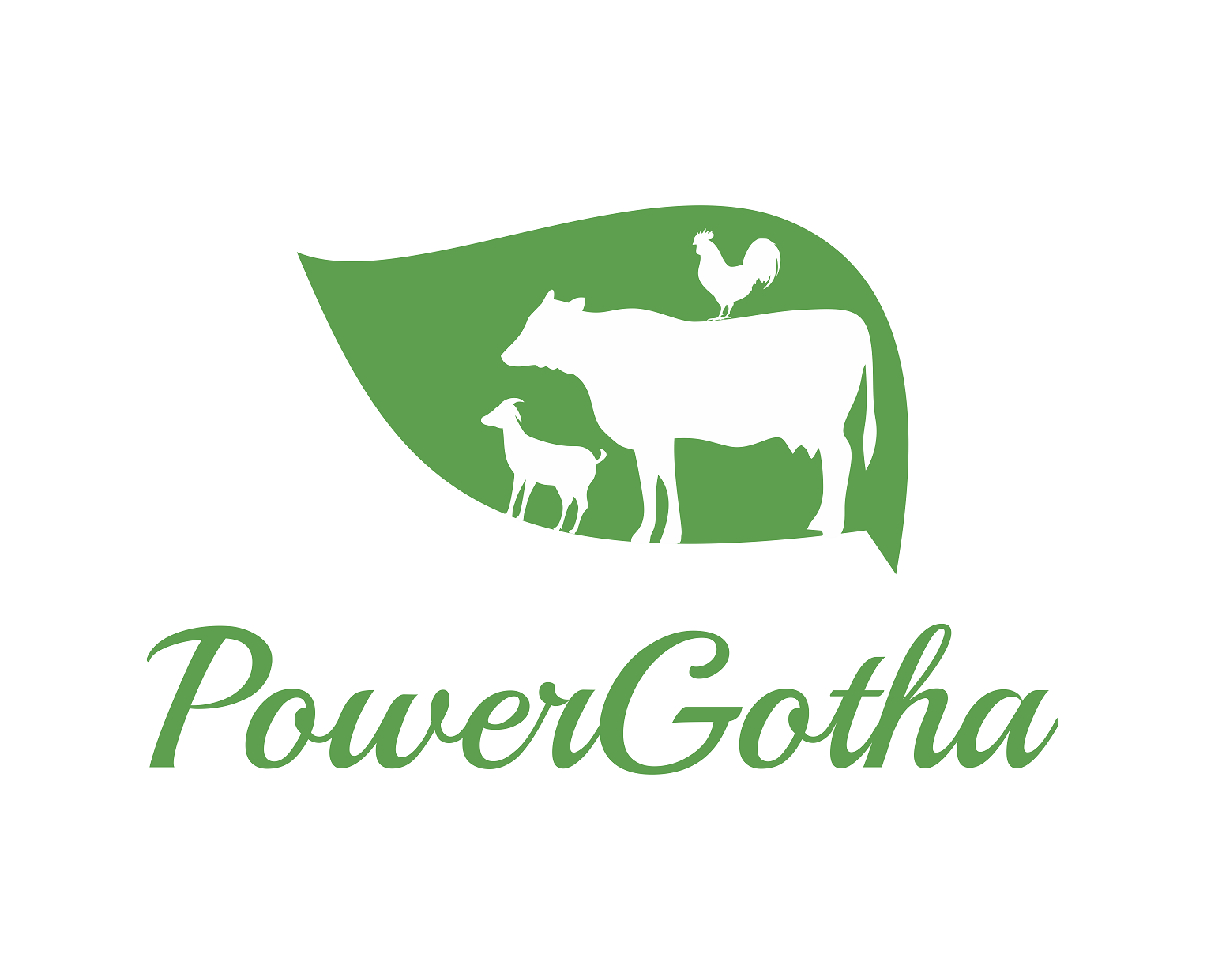
Baskar
August 16, 2020 at 7:52 pmIn tamilnadu people are talking about crossbreed called 96 ( ninty six) pls can explain this breed…body structure is in Jersey and colour is in white or shade colour
Baskar
August 16, 2020 at 7:49 pmIn tamilnadu, people are talking about crossbreed name called 96( ninty six) can u please explain about this breed body structure is in Jersey clour is in mostly white or shade white and good for milk
Gaurav Sharma
August 10, 2020 at 5:11 pmHello i am going to start a cattle farm for commercial dairy purpose in which i sell milk milk direclt to government dairy. They take milk on on fat percentage . I am from udaipur rajasthan , i am little confused which cattle is best to purchase to stablish such business..
Pls guide . So mistakes can be avaoided
saran kumar rizal
July 9, 2020 at 9:38 amLucidly written and informative
7 Cross Breeding Techniques for Dairy Farming in India | PowerGotha
March 24, 2020 at 3:35 am[…] Dairy Farming India: Details of noteworthy Crossbred Cows […]
7 Cross Breeding Techniques for Dairy Farming in India | पॉवरगोठा-PowerGotha
March 21, 2020 at 1:48 am[…] discussed in the earlier article https://powergotha.com/en/dairy-farming-india-details-of-noteworthy-crossbred-cows/ ”Cross breeding” means mating the animals of different species to produce progeny or use […]